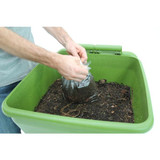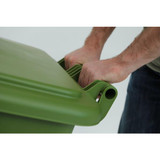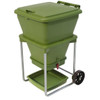
Hungry Bin - Portable Compost System
The Hungry Bin is a clean, simple and easy way to reduce your organic waste and create nutrient-rich fertilizer using compost worms! The system is des…
The Hungry Bin is a clean, simple and easy way to reduce your organic waste and create nutrient-rich fertilizer using compost worms!
The system is designed to create an ideal living environment for compost worms, allowing the worms to convert the organic waste into worm castings and a nutrient-rich liquid, which are both high-quality fertilizers!
Why the Hungry Bin?
Large Capacity
The Hungry Bin can process up to 4 pounds of organic waste per day, providing plenty of space for your kitchen waste and scraps! Reduce your trash output with this useful tool.
Ultimate Mobility
With a two-wheeled design, the Hungry Bin can be wheeled around your yard or into the garage without unneeded lifting or emptying.
Ideal Fertilizer
The Hungry Bin captures both the worm castings and nutrient-rich liquid, providing abundant amounts of fertilizer to feed your indoor or outdoor garden!
Get Started Quickly
Neatly packed in an easy-to-carry box, the Hungry Bin is simple and quick to put together. Assembly instructions and a comprehensive instruction manual are included with your bin.
Versatile Use
The Hungry Bin can help reduce waste in any environment, including in your home, restaurant, school or commercial environment! For a commercial quote, please contact us at info@hydroplexgrowers.com.
How It Works
Waste is placed directly into the top of the bin, where worms eat it as it softens and begins to decompose. The compost worms used in the bin are a different species from earthworms. Compost worms are surface feeders and prefer to live in organic material or mulch. They do not burrow into the soil like earthworms.

As the compost worms eat the waste, they convert it into worm castings. The castings are pushed down through the bin and compressed by the weight of fresh castings above. The compressed castings are retained in the lower part of the bin, where they can be simply and easily removed when needed for use as plant food or soil conditioner. In normal operation, the castings will need to be removed from the bin once every two to six months.
Liquid drains down through the bin, passes through a filter housed in the floor, and ultimately collects in a drip tray. This liquid is an ideal fertilizer. It is best to dilute the liquid with water before feeding it to plants, as it is very concentrated. A good dilution ratio is 1 part worm liquid to 10 parts water.
FAQ
What are compost worms?
Compost worms are different from common garden worms that live in soil. Unlike earthworms, compost worms do not make burrows in the soil, but live in the surface layer (the top 12"). They have evolved to eat rotting plant matter on the forest floor, and are perfectly suited to break down organic waste. Compost worms are generally smaller than earthworms.
Our compost worms are a dual species of Red Wiggler Worms (Eisenia fetida) and European Red Worms (Eisenia hortensis).
Does temperature impact my composter?
For our customers in cold weather environments, it is recommended that the Hungry Bin be located indoors during the winter months in a mild, protected location such as an enclosed garage, basement or insulated shed.
In summer months, maximize productivity by choosing a sheltered, shady spot – the ideal temperature is between 60-80 °F. Avoid extremes of temperature, particularly full sun in summer, as temperatures over 95 °F may kill the worms. You can wheel your bin between different locations depending on the weather conditions or season. If the bin is outdoors in winter, make sure it is not subjected to freezing conditions for extended periods of time.
Do I need to add water?
Generally, you should not need to add water. Food scraps have a high water content, which helps keep the bin moist. The design lets excess water drain from the bin, but ensures enough moisture is retained to maintain optimal conditions.
The worms do need to be moist though, so if the bin dries out, sprinkle a little water on the top of the bin. If you have added dry matter like shredded paper, you may also need to add water. Take care not to drown the worms; the top should only be as wet as a wrung-out sponge.
How much liquid can my bin produce?
The bin will produce about one pint of liquid per day when it has a full worm population and is fed regularly. It is important that the liquid is free to drain from the bin at all times.
If liquid from your bin is not collecting in the drip tray, it may be too dry.
The level inside has dropped. What do I do?
Just add some soil or finished compost each time you feed the Hungry Bin.
Additional Documents
Browse the following for more information about the Hungry Bin system!






























